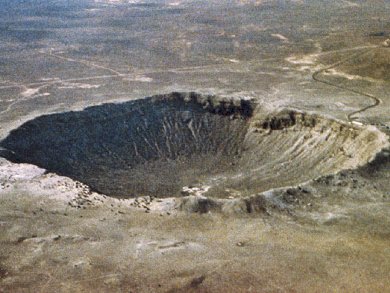The Spark of Creation
In the beginning … there was a barren spinning ball of rock, with a hot, molten core, hurtling through space around a distant, but warming fusion reactor. But the spinning ball was not alone on its journey – there were countless misshapen chunks of rock and ice and frozen gases in its vicinity, many with eccentric orbits around the central fusion reactor. These comets and other solar debris could skim past or shift in their orbits at the whim of great balls of gas and rock, although always ruled by the laws of the one they know as Kepler.
A whimsical tale of creation perhaps, but the primordial Earth was very much an inhospitable barren rock, repeatedly bombarded by space debris, asteroids, meteorites, and comets for millions of years before life arose. At some point in that history there was a spark that lit the fires of evolution. Chemists have considered many scenarios that may have led to the spark. Among the most intriguing is that those devastating, to our modern eyes, cometary impacts may have brought with them not only the water to fill the oceans but the small and simple organic molecules that would mindlessly seek refuge in each other’s company and ultimately bond to form complicated, self-replicating entities. Those chemical species perhaps sequestered themselves into the clays and coatings on submarine surfaces and ultimately spilled into the seas as the very first and most primitive living cells. The rest, as they say, would be biological history.
Modeling Cometary Impacts on Earth
Nir Goldman of the Physical and Life Sciences Directorate, Lawrence Livermore National Laboratory, California, USA, and Isaac Tamblyn of the Department of Physics, University of Ontario Institute of Technology, Oshawa, Canada, have modeled the kind of shock pressures that might have existed as an icy body, such as a comet, smashed into our planet. Their quantum molecular dynamics (MD) simulations of a carbon dioxide-rich icy mixture spanned pressures up to 60 GPa and temperatures up to 4600 K (1 GPa is approximately 10,000 times Earth’s atmospheric pressure at sea level). These conditions encompass highly probably comet impact scenarios on early Earth.
At pressures of 36 GPa and 2700 K, the team showed that a number of nitrogen-containing heterocycles could form, which decompose to functionalized aromatic hydrocarbons upon expansion and cooling to ambient conditions. Slightly higher impact pressures (48–60 GPa) and temperatures (3700−4800 K), yielded long carbon-chain molecules, methane, and formaldehyde upon expansion and cooling. The team add that in all of their reactive shock compression simulations, they observed new C–N bonded compounds such as HCN, HNC, and HNCO once the pressure was released and the system cooled to ambient conditions. “All of these molecules are known precursors for amino acids, polypeptides, DNA and RNA nucleobases, and other life building compounds,” Goldman told ChemViews magazine.
Synthesis Mechanism Free of External Constraints
While the well known experiments of Stanley Miller and Harold Urey at the University of Chicago and later the University of California, San Diego, both USA, in the 1950s, hinted at how organic molecules might form under certain conditions thought to prevail on the early Earth, the present study does not invoke any special conditions. “Our results elucidate a mechanism for impact synthesis of prebiotic molecules at realistic impact conditions that is independent of external constraints such as the presence of a catalyst, ultraviolet radiation, or pre-existing conditions on a planet,” the team says. That conclusion, of course, also hints at the possibility that the same mechanisms might have occurred or might yet occur elsewhere in the universe.
Uwe Meierhenrich of the Université de Nice-Sophia Antipolis in Nice, France, describes the Goldman and Tamblyn results as showing, in “a very beautiful manner”, that molecular dynamics (MD) simulations as well as quantum chemical calculations based on density functional theory (DFT) do more than support laboratory experiments. “In this particular case, MD simulations obtained important information on potentially prebiotic chemical reaction pathways that are assumed to occur under high pressure and high temperature conditions inaccessible in the laboratory,” he told ChemViews magazine. “This study will certainly drive future lab experiments to confirm the theoretically predicted chemical reactions and will impact the astrophysics and meteorite community,” Meierhenrich adds.
Image: National Aeronautics and Space Administration (NASA), Washington, D.C., USA.
- Prebiotic Chemistry within a Simple Impacting Icy Mixture,
Nir Goldman, Isaac Tamblyn,
J. Phys. Chem. 2013.
DOI: 10.1021/jp402976n




